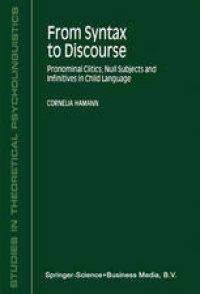
Ebook: From Syntax to Discourse: Pronominal Clitics, Null Subjects and Infinitives in Child Language
Author: Cornelia Hamann (auth.)
- Tags: Psycholinguistics, Comparative Linguistics, Germanic Languages, Romance Languages
- Series: Studies in Theoretical Psycholinguistics 29
- Year: 2002
- Publisher: Springer Netherlands
- Edition: 1
- Language: English
- pdf
claim is that such morphological processes can be learnt without symbolization and innate knowledge. See Rumelhart and McClelland (1986) for the original model of past tense acquisition, Plunkett and Marchman (1993), Nakisa, Plunkett and Hahn (1996) and Elman et al. (1996) for developments and extensions to other morphological processes, and Marcus et al. (1992) and Pinker and Prince (1988) for criticism. One line of investigation supporting the view of language as a genetic endowment is closely linked to traditional research on language acquisition and argues as follows: If language is innate there must be phenomena that should be accessible from birth in one form or the other. Thus it is clear that the language of children, especially young children and preferably babies should be investigated. As babies unfortunately don't talk, the abilities that are available from birth must be established in ways different from the usual linguistic analysis. Psycholinguistic research of the last few years has shown that at the age of 4 and 8 months and even during their first week of life children already have important language skills. From the fourth day, infants distinguish their mother tongue from other languages. From the first months children prefer the sound of speech to 'other noise'. At the age of 4 months, infants prefer pauses at syntactic boundaries to random pauses.
This book investigates typical phenomena of early child language from a cross-linguistic perspective. The investigation centers on the acquisition of pronominal clitics in production and comprehension, and especially on the well-known phase of infinitive production and subject omission. Other areas such as early negation and question-formation are treated in the context of the above phenomena. The book provides a unique comparative database for these areas of language acquisition from the point of view of Romance and Germanic languages in presenting results on Danish, Dutch, English, French, German, and other languages. On the basis of these broad and detailed empirical results, the author proceeds to evaluate current models and hypotheses advanced for the above phenomena from a theoretical perspective. A formal investigation of the semantics and pragmatics of pronouns and tense leads to the conclusion that discourse anchorage, which is problematic for young children, is mediated by syntax and by functional material in particular so that the development of the syntax-discourse interface is largely driven by developments in syntax. In relating unusually comprehensive cross-linguistic child data to unusually fine-grained formal analyses, the book thus succeeds in providing new insights not only into language development but also into linguistic theory.